Competition
I. A general definition of competition: an interaction between individuals
brought about by a shared requirement for a resource in limited supply,
leading to a reduction in survivorship, growth, and/or reproduction of the
individuals concerned.
A. What sorts of interactions are we referring to? These fit into broad
categories of exploitation and interference as discussed in the lab manual.
B. They can be subdivided into more specific ways that individuals may
compete.
1. Exploitation--depleting resources
2. Pre-emptive--using space
3. Overgrowth--species growing over another and depriving the other
of light
4. Chemical--production of toxins
5. Territorial--behavior or fighting in defense of space
6. Encounter--transient interactions directly over a specific resource
II. Intraspecific competition (Intra means within)
A. Individuals of the same species have very similar resource requirements
and if these resources are limiting, they will compete for access.
B. The logistic growth equation describes growth within a species when
a density dependent factor such as competition occurs, but competition
can also occur between species.
III. Interspecific competition (Inter means between/among)
A. Definition of interspecific competition: individuals of one species
suffer a reduction in fecundity, survivorship, or growth as a result of
resource exploitation or interference by individuals of a second species.
B. How do we experimentally determine whether competition occurs between
two species?
1. Removal experiments
a. Nelson Hairston, Sr.'s experiments on two species of plethodont salamanders.
Plethodon glutinosus and P. jordani whose distributions sometimes
overlap in the Southern Appalachians. He created experimental plots and
used three treatments: remove all P. jordani, remove all P. glutinosus,
and a control treatment where he left existing abundances. In the control
plots and naturally P. jordani was the more abundant of the two species.
In the plots where it was removed, the abundance of P. glutinosus
increased, indicating that P. jordani was in some way limiting its
increase. But when the reciprocal treatment was examined, P. jordani
did not increase in the absence of P. glutinosus.
b. Joseph Connell's work on two species of barnacles in Scotland.
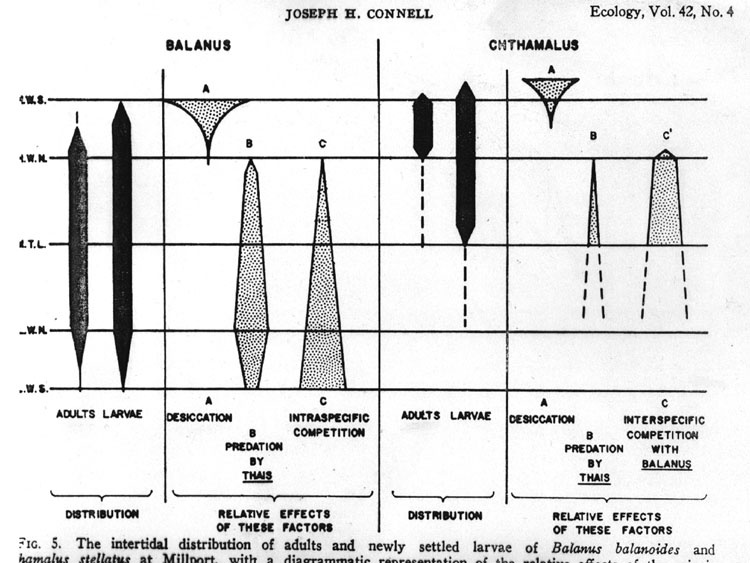
IV. Comparison and contrast between intra- and interspecific competition.
- The basic mechanisms of exploitation and interference are similar.
- Interspecific competition does differ in three ways.
1. Individuals of different species don't use all the same resources.
2. Individuals of different species don't use resources in exactly the
same way.
3. Interspecific competition is more likely to be asymmetrical.
V. An organism's niche is a way of envisioning the environmental conditions
where an organism can survive. Organisms survive, grow, and reproduce only
within certain limits. For example, temperature, humidity, current flow
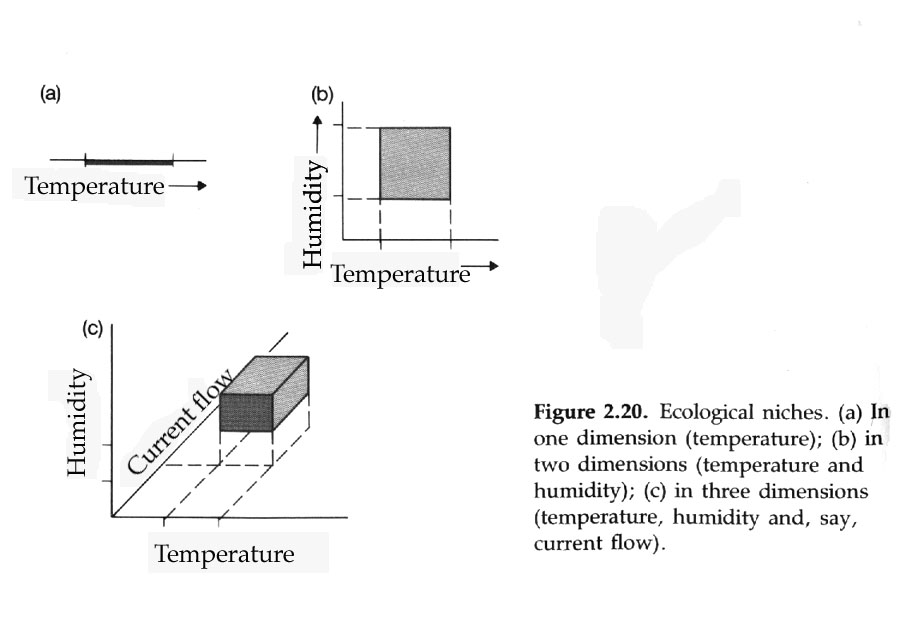
A. Two types of niches
- Fundamental: the overall potential conditions under which a viable
population can be maintained.
- Realized: the precise nature of an organisms niche as dictated by competing
species and predators.
B. Competitive exclusion principle: that two competing species cannot
coexist in a stable environment, unless their realized niches differ.
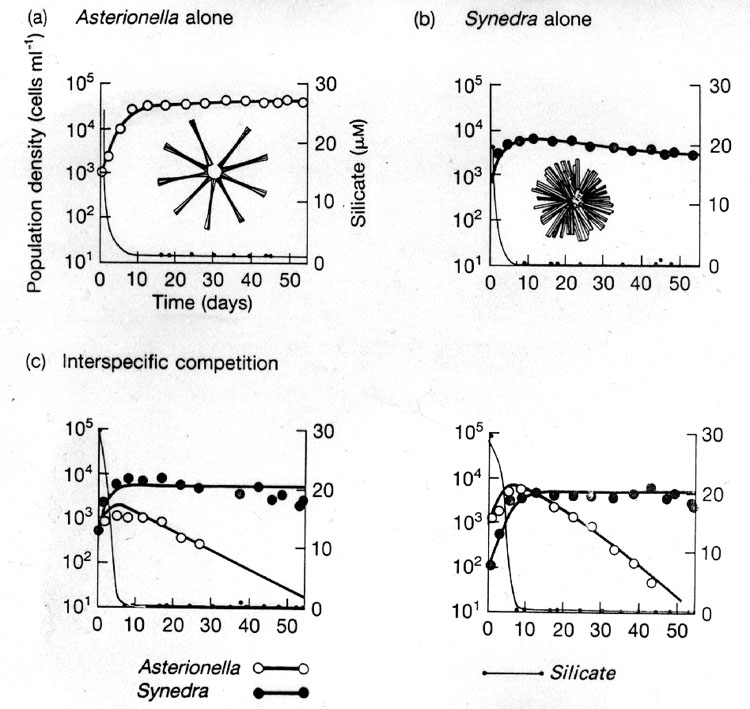
C. How do species coexist?
1. Niche differentiation: species may specialize on part of their fundamental
niche, the realized niche Ex. Cattails. Typha latifolia and T.
angustifolia.
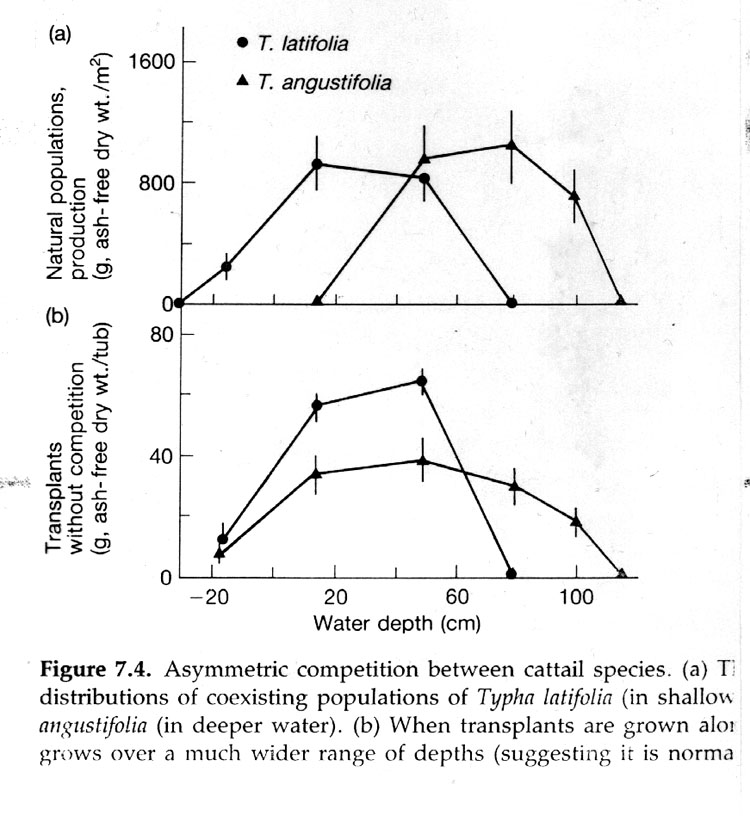
2. Character displacement: morphology differs when in sympatry to when
in allopatry.
Ex 1.Change in bill morphology of House Sparrows when House Finches
were introduced. Ex 2. Veromessor ants.
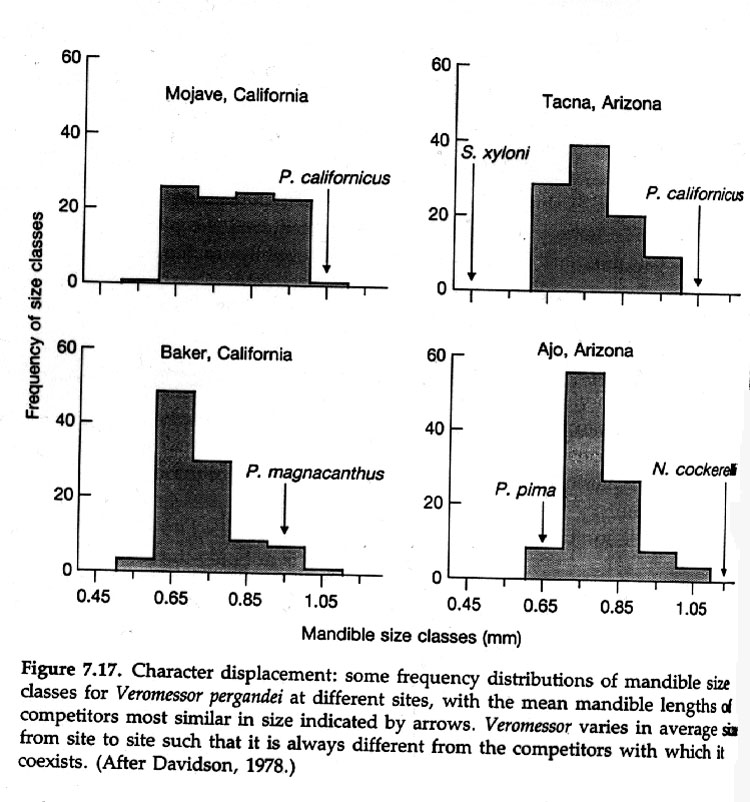
- "Paradox of the plankton" Paradox is that numerous species
of planktonic algae coexist in very simple environments with little apparent
scope for niche differentiation. Hutchinson proposed that the environment
was continually changing--although it was simple. Change would promote
the exclusion of a certain species but before an equilibrium or total exclusion
could occur, the environment would change and another species might be
favored. Since all environments vary, this may be a very important factor
by shifting competitive balances.
- Are there general conditions under which coexistence between species
is likely to occur?
- Use modeling done by Lotka and Volterra to address this.Lotka and Volterra
modified the logistic growth equation dN/dt = rN(K-N)/K (which is the same
as dN/dt = rN[(1-(N/K)] to include interspecific competition effects.
B. How does species 2 affect species 1? Look at rate of change dN1/dt
1. If they were equal competitors, we could simply add them:
dN1/dt = rN1[K1-(N1+N2)]/K1
- Species are seldom equivalent in their competitive abilities.
- Add one new variable alpha (ato describe the relative effects of an
individual of one species on an individual of another.
dN1/dt = rN1[K1-(N1+a12N2)]/K1
a12= the effect ON species 1 OF species 2
4. Alpha adjusts the number of N2 to being equivalent to N1. For example,
if N2 is a really good competitor so that having 1 N2 around is similar
to having 10 N1, alpha would be 10. If it is a lousy competitor so that
10 N2 have the same effect as 1 N1 alpha would be 0.1.
5. A similar equation applies to N2 except that the alpha has a different
subscript combination to reflect that the species effects may not be reciprocal.
dN2/dt = rN2[K2-(N2+a21N1)]/K2
a21 =the effect ON species 2 OF species 1
6. When no competitor is present, the equations reduce to the logistic
growth equation.
7. We want to know how population size of species 1 and species 2 change
in response to each other.
8. To determine the dynamics between species 1 and species 2, we can
find the line of equilibrium where dN/dt=0 (also known as zero isocline)
for each species. Species 1 is at equilibrium when K1-(N1+a12N2) = 0, and
Species 2 is at equilibrium when K2-(N2+a21N1) = 0. We can plot the lines
of equilibrium for each species.
9. Four possible outcomes of competition based on the model.
a. Species 1 always wins.
b. Species 2 always wins.
c. Coexistence of species below each K.
d. Which species wins depends on starting conditions (Ex. Diatoms)
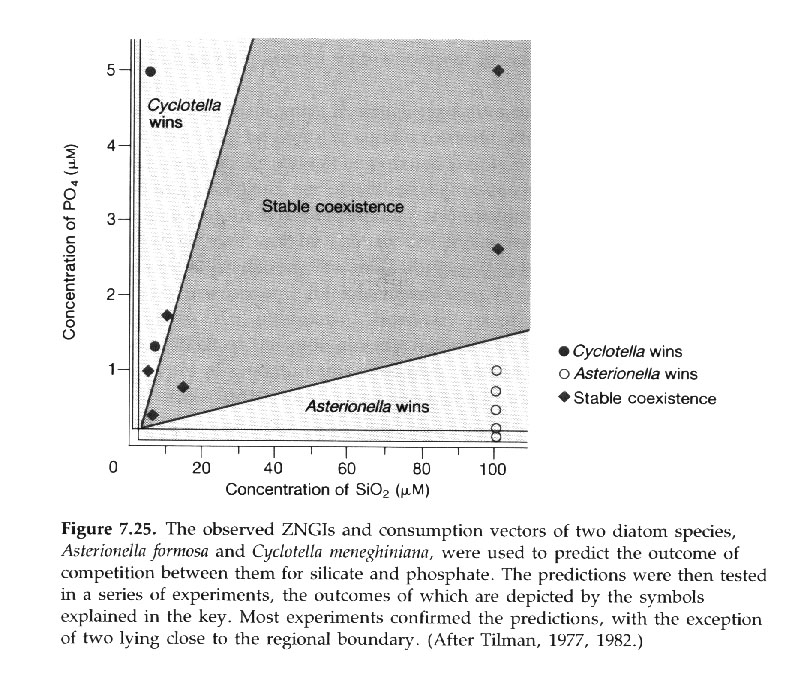
By the end of this lecture you should understand 1) the important components
in the definition of competition; 2) similarities and differences between
intraspecific and interspecific competition; 3) how studies of competition
are designed and how results are interpreted; 4) the concept of niche; 5)
the competitive exclusion principle; 6) how similar species are able to
coexist; 7) the terms of the Lotka-Volterra competition equation; 8) the
consequences for competition interactions that the model predicts; 9) how
the competition equation and the logistic growth equation are similar and
different.





